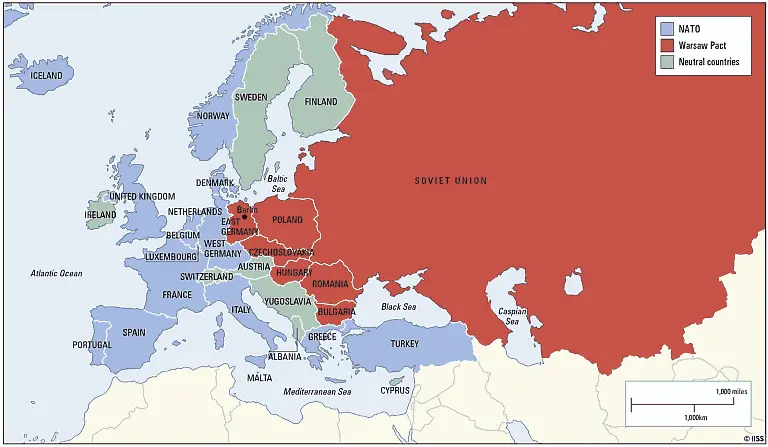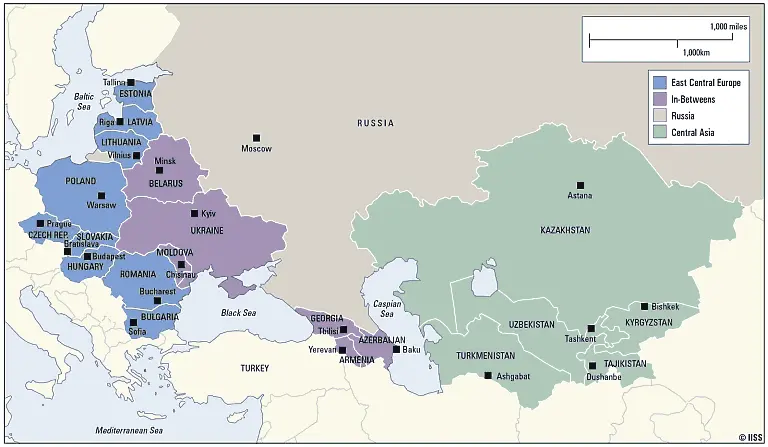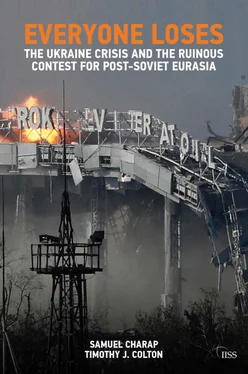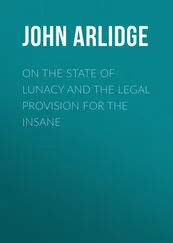31 December 2005 — First Russia–Ukraine gas war begins
12 December 2007 — Putin suspends implementation of CFE agreement
2 March 2008 — Dmitry Medvedev elected president of Russia
2–4 April 2008 — NATO Bucharest summit communiqué declares Georgia and Ukraine ‘will become’ members of Alliance
5 June 2008 — Medvedev calls for new European security treaty
8–12 August 2008 — Russia–Georgia war
26 August 2008 — Russia recognises independence of Abkhazia and South Ossetia
31 December 2008 — Second Russia–Ukraine gas war begins
7 May 2009 — Launch of EU Eastern Partnership initiative
9 June 2009 — Russia, Kazakhstan and Belarus announce formation of Customs Union
29 November 2009 — Russia publishes draft European Security Treaty
25 February 2010 — Viktor Yanukovych elected president of Ukraine
15 April 2010 — President Kurmanbek Bakiev ousted in Kyrgyzstan
21 April 2010 — Yanukovych signs 25-year extension of lease on Russian Black Sea Fleet base in Crimea in return for discounted gas price
31 May 2010 — Russia and EU launch Partnership for Modernization
20 November 2010 — NATO–Russia Council agrees to ‘work towards achieving a true strategic and modernised partnership’ at Lisbon summit
4 March 2012 — Putin elected to third term as president of Russia
30 March 2012 — Ukraine and EU initial AA
3 September 2013 — President Serzh Sargsyan announces Armenia will scrap AA and join EEU
21 November 2013 — Ukrainian government suspends preparations for AA with EU
28–29 November 2013 — At EU Eastern Partnership summit in Vilnius, Yanukovych refuses to sign AA despite intense pressure from EU leaders
30 November 2013 — Police crack down on students demonstrating in Kyiv against decision not to sign AA
17 December 2013 — Putin promises US$15bn in credits to Ukraine and cut in the gas price by one-third
18–20 February 2014 — Dozens of protesters and police killed in bloodiest days of the Maidan Revolution
21 February 2014 — Yanukovych and three opposition leaders sign agreement calling for government of national unity, constitutional reform and new presidential election
22 February 2014 — Yanukovych flees Kyiv; Verkhovna Rada votes to remove him from office
25–28 February 2014 — Russian reinforcements arrive in Crimea and fan out across the peninsula
1 March 2014 — Putin obtains formal approval from upper house of parliament to deploy military forces on Ukrainian territory
15 March 2014 — Russian Foreign Minister Sergei Lavrov presents US Secretary of State John Kerry with draft ‘Friends of Ukraine’ action plan
16 March 2014 — Contested plebiscite held in Crimea; overwhelming majority of voters said to support unification with Russia
17 March 2014 — US and EU enact sanctions against Russia
18 March 2014 — Putin delivers blistering speech denouncing Western foreign policy and announcing the ‘reunification’ of Crimea with Russia
15 April 2014 — Ukrainian government launches ‘anti-terrorist operation’ against Russia-backed anti-Maidan protesters who had taken up arms and seized administrative buildings in southern and eastern Ukraine
25 May 2014 — Petro Poroshenko elected president of Ukraine
27 June 2014 — Georgia, Moldova and Ukraine sign AAs with EU
16 July 2014 — US Treasury Department implements sanctions on Russia’s financial, defence and energy sectors
17 July 2014 — Downing of Malaysia Airlines passenger jet over the Donbas
7 August 2014 — Russia retaliates against sanctions with bans on imports of agricultural goods and foodstuffs
2 September 2014 — Separatist counter-offensive, backed by Russia, ends in major Ukrainian defeat at Ilovaisk
5 September 2014 — Representatives of Ukraine, Russia, the DNR and LNR sign ceasefire in Minsk, Belarus (‘Minsk I’)
1 January 2015 — EEU launched
14 January–20 February 2015 — Second Russian direct military intervention ends in capture of Debaltseve
12 February 2015 — Angela Merkel, François Hollande, Putin and Poroshenko agree on second peace plan (‘Minsk II’)
12 August 2015 — Kyrgyzstan joins EEU
21 December 2015 — Russia–Ukraine–EU trade talks break down in acrimony
1 January 2016 — Ukrainian DCFTA goes into effect; Russia suspends CIS trade preferences for Ukraine in retaliation
Samuel Charapis Senior Fellow for Russia and Eurasia at the International Institute for Strategic Studies, based in the Institute’s Washington DC office. Prior to joining the Institute, Samuel served as Senior Advisor to the US Under Secretary of State for Arms Control and International Security, and on the Secretary of State’s Policy Planning Staff.
Timothy J. Coltonis Morris and Anna Feldberg Professor of Government and Russian Studies, Harvard University. He is a specialist on Russian and Eurasian politics and the author of Yeltsin: A Life (Basic Books, 2008), Russia: What Everyone Needs to Know (Oxford University Press, 2016) and other works. He is a Fellow of the American Academy of Arts and Sciences.
Map 1: Cold War military alliances, 1989

Map 2: Military alliances and economic blocs, 2016

Map 3: East Central Europe and Post-Soviet Eurasia

Map 4: Separatist-controlled territory in eastern Ukraine, November 2016

Western readers of the morning’s headlines in 2014 realised to their surprise and dismay that post-Cold War Europe was at war. The local conflagrations triggered by the break-up of the Soviet Union and Yugoslavia in the 1990s were bloodier, but the Ukraine crisis occurred long afterwards and revived fears of a clash between major world powers. The United States and the member states of the European Union (EU) adopted positions diametrically opposed to those followed by post-Soviet Russia. Ukraine and its people were caught in between. Today, Europe is divided once again, although the divisions lie farther east than they did before the fall of the Berlin Wall. These new demarcation lines are unstable and reflect neither local affinities nor great-power consensus. There is talk in world capitals of a new cold war, a protracted period of tensions when destabilising and even catastrophic conflict is an ever-present danger.
Читать дальше















